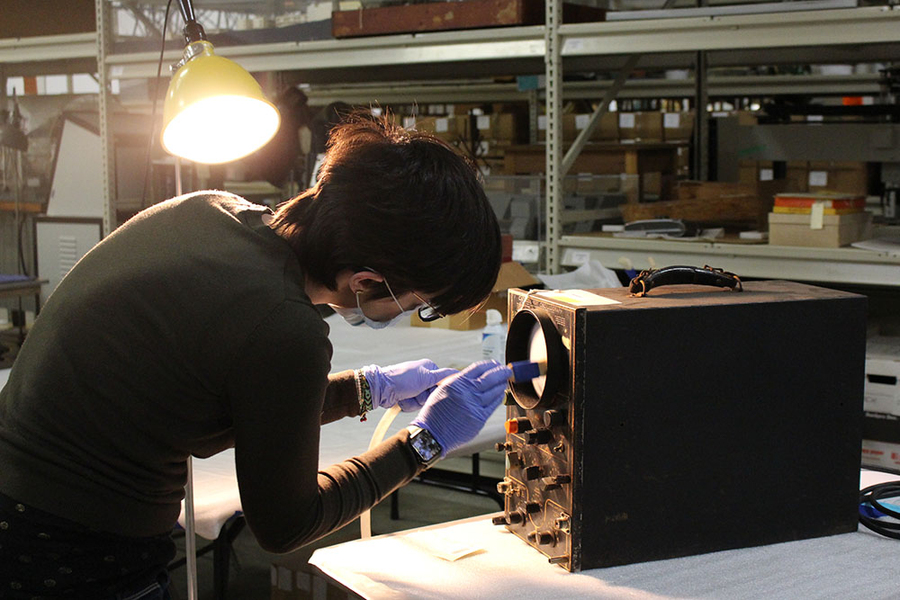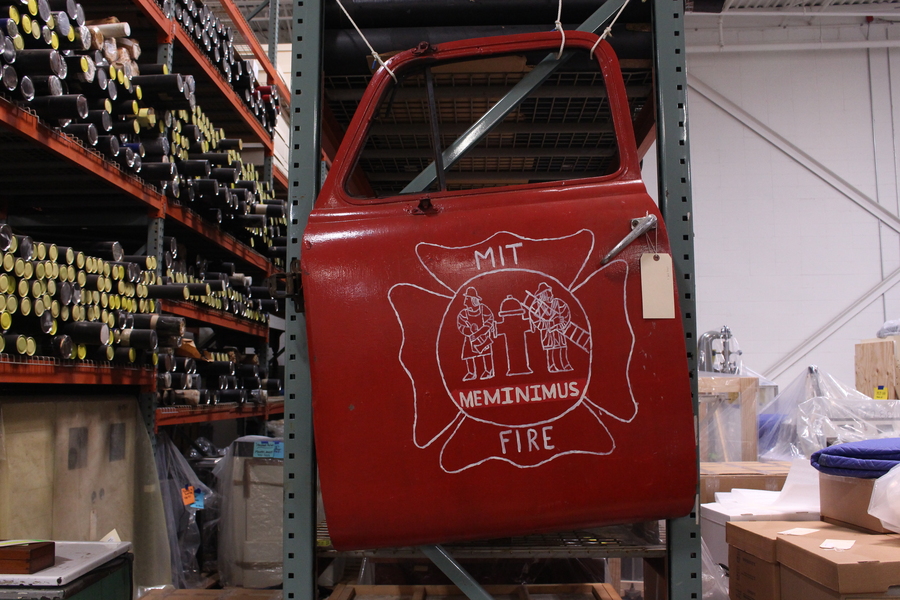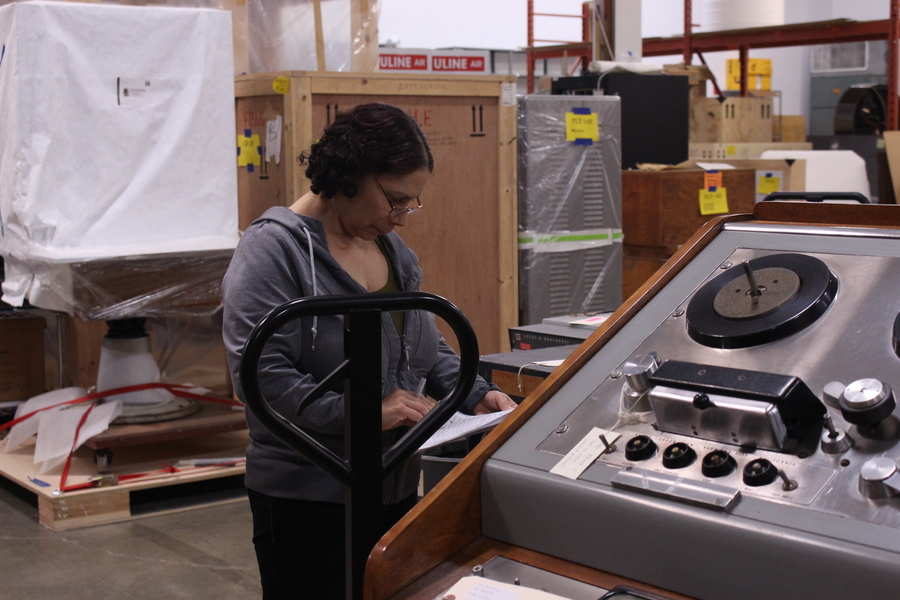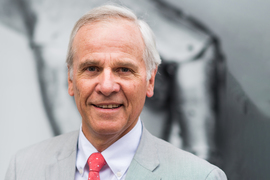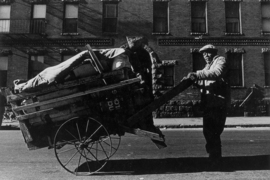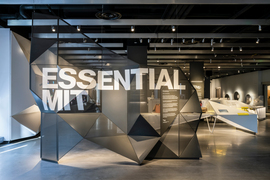Gloria Martinez has a million-and-a-half items on her to-do list.
Quite literally: Give or take a few hundred thousand, that's the number of unique objects in the MIT Museum's astonishingly diverse collection. Martinez is supervising the collection's move to a new storage facility — the final step in delivering the new museum, whose headquarters opened last fall in the heart of Kendall Square.
Only a tiny fraction of the huge collection is on display at the popular new museum. Working under tight deadlines, Martinez and her team are painstakingly gathering details on the vast store, now held at a warehouse and at the previous site of the museum, and packing everything for transfer to another storage facility a few miles away.
Martinez, a master of the art and science of handling museum artifacts, faces a bewildering and ever-changing array of logistical challenges. “My day might look one way on my calendar in the morning, and turn into something completely different once I start,” she says.
Casting a wide net
Artifacts such as lab devices, ship models, and architectural plans are critical for understanding the Institute past and present, says Deborah Douglas, the museum's director of collections and curator of science and technology.
“The museum was formed around its objects, and has been systematically accumulating those artifacts over the past 50 years,” Douglas says. “The aim is not simply to document the triumphs of MIT, but to tell the story of science, technology, architecture, and all of the endeavors that the people of the Institute have engaged with in the 19th, 20th, and 21st centuries.”
“It's an encyclopedic collection,” she adds. The treasure trove holds, for example, plans for America’s Cup-winning yachts, 100 years of architecture student thesis drawings (including those of Robert Taylor, the first trained Black architect in the United States), one of the first aluminum-framed bicycles, human-powered airplane parts, holograms (lots of holograms!), thoroughly offbeat lab instruments, folded-paper items, costumes, trophies, massive chunks of physics experiments and early computers, and remnants of MIT's famous hacks, such as a door from the firetruck that appeared on the Great Dome in 2006 to mark the fifth anniversary of 9/11.
Florencia Pierri, assistant curator for science and technology, heard about the vast size of collection when she was hired. “But it's different,” she says, “to actually climb a ladder for the first time and survey the rows and rows and rows of 10-foot-tall shelves just chock full of stuff.”
Planning the process
Drawn by the scale of the challenge, Martinez joined the museum in 2019. Collaborating with museum registrar Katie Porter, she began quietly exploring the collection and sketching out plans for the move.
The next year, when the pandemic hit, MIT's lockdown policies drastically shrank the hours that anyone could work at the warehouse. “To be honest, Covid afforded me the opportunity to have that time exclusively just to plan and prepare for the projects,” she recalls.
As is common in museums, much of what MIT held was barely described in the museum's collection database. “Gloria insisted on a level of inventory review that will make the collection much more accessible online, so that it will become much easier for people on campus and around the world to understand what we have,” Douglas says.
By 2021, the museum had recruited three assistant curators who could bring their expertise to that job (and were starting to grasp just how much effort it would entail). Martinez also hired and trained a packing team of four people with a background in handling museum items.
She constantly revised plans and processes for the move. All of the museum's 20,000-or-so three-dimensional objects needed good photographs, so the team set up an ad hoc but highly effective photo station. Another issue cropped up with the sheer physicality of the objects, which might weigh 80 or 150 pounds. Grappling all day with these might lead to injuries or other accidents, so she aimed to shorten the work sessions.
“Processing the endless stream of items can be draining, physically and intellectually,” says Jon Duval, assistant curator of architecture and design. “But it's fun,” he says. “It's a joy to be around people who get equally excited about museum work and about artifacts, and to learn things from everyone else who's there. Or to look at something that we have no idea about, and try to figure out what it might be.”
“It's so great to have a team,” says Elisabeth (“Libby”) Meier, assistant curator for the museum's Hart Nautical Collection. “Gloria is a wizard at scheduling and making sure materials are where they need to be. And working with the other curators on things that aren't in my collection is fascinating, because I generally don't know what's coming out of the box, and they generally do.”
Puzzling out objects
There's no lack of artifacts that call for quick detective work.
Among the surprises was something that the collection database described simply as a brick. “I noticed it because I tried to move it and it was a lot heavier than I thought it would be,” says Pierri. She discovered that the “brick” was part of a graphite rod created for the world's first human-made self-sustaining nuclear chain reaction, at the University of Chicago in 1942.
Another unexpected find was two empty leather trunks that were falling apart and seemed to be overdue for the trash. But the trunks belonged to Katharine Dexter McCormick, the first woman to earn an MIT science degree and the main source of funding for the development of the first birth control pill. McCormick used the trunks to smuggle diaphragms from Europe to the United States in the 1920s, Pierri says.
An even stranger curiosity was a box of rusted cans — grocery store items employed in influential experiments with bar codes, says Duval.
Not every surprise during the inventory is so compelling, and not everything is kept. “Maybe we don't need quite so many toenail clippers from the contents of somebody's desk drawer,” Douglas says.
Connecting with the collection
With steady progress on an upgraded inventory, the packing team moved into high gear last November. Everything will be out of the current warehouse by December 2023, and out of the former museum site by July 2024.
Martinez keeps fine-tuning her plans as situations and timelines change. “It's been very fluid,” she says. “You can't be rigid in this profession. If you are, you really need to find another job.”
“For the last couple of years, we've been doing this nonstop, and it will require a lot more hard work and additional reinforcements” says Martinez, who adds that she's just starting to see the light at the end of the tunnel.
“Gloria has done an extraordinary job,” says Douglas. “She's created a really intelligent approach to inventorying, but then also created a plan for packing all the material that lets us be much more efficient in our moving process.”
“Ultimately, the goal of all this moving stuff around is to make it even more accessible,” Douglas says. “This is material that you can use to teach with, do research with, stimulate academic and entrepreneurial endeavors, and to educate — whether yourself or the broader community. If we can help inspire people, if we can help educate people, or provide useful resources for the work that's going on today or in the future at MIT and beyond, then we will have accomplished our mission.”
